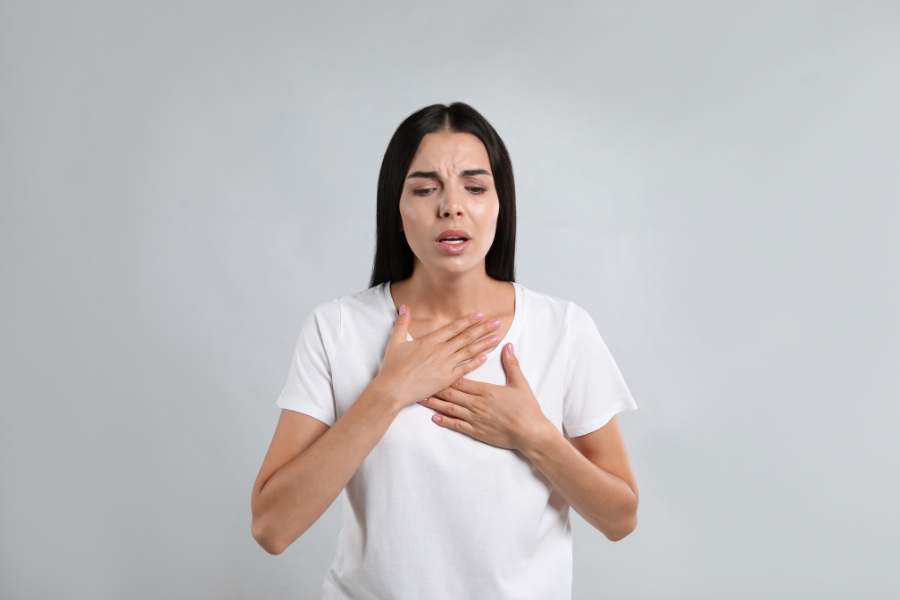Struggling to catch your breath can be a frightening experience, often leading to a frantic search for answers. Difficulty breathing, or dyspnea, can arise from various underlying issues, which we will explore in this comprehensive guide.
Whether it’s a fleeting sensation after a vigorous workout or a persistent discomfort disrupting your daily life, understanding the possible causes and treatments is crucial to managing your health. Let’s delve into the intricacies of this common yet complex symptom.
What is difficulty breathing?
Difficulty breathing, medically termed dyspnea, is the feeling of inadequate or uncomfortable breathing. It’s a symptom of many different conditions, from the benign to the serious. People often describe it as a feeling of breathlessness or a tight chest, and it can be a temporary response or a chronic issue.
Understanding the nature of dyspnea is essential. It can present itself during exertion or even at rest. In some cases, difficulty breathing can be a sign of a more significant health problem, like heart or lung disease, and warrants immediate medical attention.
The sensation can vary greatly, with some individuals reporting a heavy chest, while others feel like they can’t get enough air, regardless of how deeply they breathe. Recognizing when and how dyspnea occurs can be critical in pinpointing its cause.
What are the common causes of difficulty breathing?
The triggers for difficulty breathing are numerous and range from lifestyle factors, such as obesity or lack of fitness, to serious medical conditions like asthma, COPD, or heart disease. Infections like pneumonia or COVID-19 can also lead to breathing difficulties.
Environmental factors, such as allergens and pollution, can exacerbate pre-existing conditions, leading to dyspnea. It’s also not uncommon for stress and anxiety to cause episodes of breathlessness, highlighting the complex relationship between mental and physical health.
Being aware of associated symptoms is crucial when determining the cause of difficulty breathing. Chest pain, fever, or a rapid onset can indicate a more significant health concern such as pulmonary embolism or hypoxia, situations in which urgent care is necessary.
What are the symptoms associated with difficulty breathing?
- Chest tightness, often described as a squeezing or heavy sensation
- Wheezing, a whistling sound when you breathe
- Rapid, shallow breathing
- Coughing, which may be chronic or associated with physical activity
- Fatigue, which can be due to the extra effort required to breathe
How is difficulty breathing diagnosed?
To diagnose difficulty breathing, doctors will perform a physical examination, listen to your lungs, and review your medical history. They might also order tests like chest X-rays, CT scans, or pulmonary function tests to further investigate the causes.
Blood tests can be used to check for signs of infection or anemia, which can affect breathing. In some cases, a heart evaluation including EKGs or stress tests might be necessary to rule out cardiac causes.
Your doctor may also inquire about any recent travel, potential exposure to allergens, or if you’ve experienced similar episodes in the past. All these details contribute to a holistic understanding of your symptoms.
What are the treatment options for difficulty breathing?
Treatment for difficulty breathing will depend on the underlying cause. In cases of infections, antibiotics or antivirals may be prescribed. For chronic conditions like asthma or COPD, long-term medication management is often necessary.
Oxygen therapy can be a lifesaver in situations where blood oxygen levels are low. Additionally, lifestyle changes such as quitting smoking, losing weight, and regular exercise can greatly improve breathing difficulties.
In emergency situations, where breathing is severely compromised, immediate medical intervention is required to secure the airway and support breathing, possibly with mechanical ventilation.
When should you seek medical help for difficulty breathing?
If difficulty breathing comes on suddenly, is severe, or is accompanied by symptoms like chest pain, fainting, or swelling in the feet and ankles, seek emergency medical help. These could be signs of a serious condition like heart failure or a pulmonary embolism.
It’s also important to get medical attention if you notice a chronic change in your breathing patterns, as this could indicate a progressive respiratory or cardiac condition needing treatment.
For those with known conditions like asthma, it’s crucial to recognize when your normal management isn’t effective. An asthma action plan, often discussed with your doctor, can guide you on when to seek help.
What are the home remedies for difficulty breathing?
For non-emergency cases, certain home remedies can help alleviate difficulty breathing. Practicing deep breathing exercises can improve lung efficiency, while steam inhalation may relieve congestion.
Staying hydrated is essential, as it helps to thin mucus, and using air purifiers can reduce airborne irritants. If overweight, working towards a healthy weight can make a significant difference in breathing ease.
Natural remedies, such as peppermint or eucalyptus oils, have properties that might help with breathing when used in aromatherapy, though it’s essential to approach these remedies with caution and consult a healthcare provider.
Related Questions on Difficulty Breathing
What are the top 3 causes of shortness of breath?
The three most common causes of shortness of breath are asthma, heart disease, and chronic obstructive pulmonary disease (COPD). Each of these conditions affects the airways or heart function, leading to a sensation of breathlessness.
While these are common causes, it’s also important to consider other potential factors, like anxiety or obesity, which can also lead to difficulty breathing.
How do I know if my shortness of breath is serious?
Shortness of breath is serious if it is sudden, severe, or accompanied by symptoms like chest pain, blue lips or face, or an inability to speak. It could indicate a life-threatening condition, and immediate medical evaluation is crucial.
If you have a pre-existing condition like asthma, and your usual medication isn’t helping, that’s another sign that you need to seek medical help promptly.
Why do I feel like I can’t take a full breath?
Feeling unable to take a full breath can be due to various causes, such as constriction of the airways, weak respiratory muscles, or psychogenic factors like stress. It’s a symptom that can be evaluated with a physical exam and potentially imaging or pulmonary function tests.
Determining the underlying cause can aid in creating a treatment plan that might include medications, breathing exercises, or addressing anxiety if it’s a contributing factor.
What to do if someone is struggling to breathe?
If someone is struggling to breathe, call for emergency help immediately. While waiting for help, encourage the person to take slow, deep breaths and loosen any tight clothing. If they have a known breathing condition and medication for it, assist them in taking it.
Keeping the person calm is vital, as panic can worsen the sensation of breathlessness. Ensure a supply of fresh air, and if trained, be prepared to perform CPR if the person stops breathing.
For more tailored advice on managing difficulty breathing and understanding your symptoms, consider visiting the “Doctor 24 Hours Palamanova Mallorca” clinic. Their team of medical professionals can provide the care and guidance necessary for coping with this condition.

